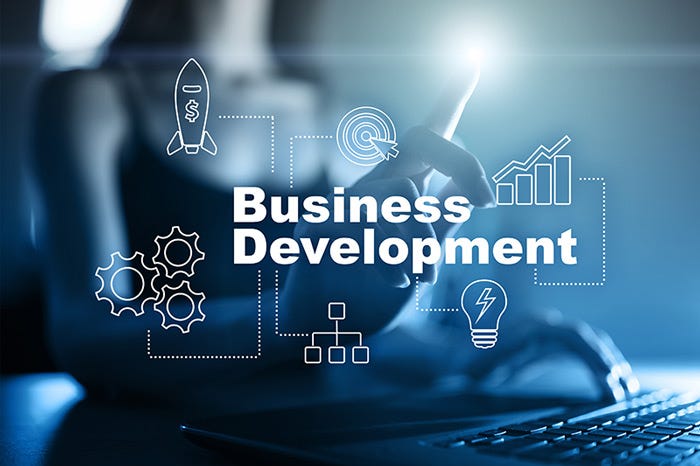Understanding Enterprise and Business Development

Definition and scope
Enterprise and business development can be defined as holistic pursuits in the nature of getting vent on more and better performance from an organization. Fundamentally, enterprise development involves any combination of strategic measures toward the creation of long-term value while continuously seeking and exploiting new opportunities.
This comprises strategic partnering, building market share and the creation of new strategic customer value solutions. Business development looks at the part of growth related to more than revenue; it also includes the increasing in profit, over cost reductions. Both these aspects, however, form the constituent part of a general business effort to shape an enhancement of structural and operational well-being for attaining a competitive advantage in the market. Anyone managing an organization that needs to embrace change surely needs to find relevance here for the scopes of these domains.
Key components and objectives
Enterprise and business development key components and objectives have always evolved around growth-driving and sustaining competitive advantage. An essential business development will also be a primary component that coordinates sales and marketing strategies to achieve business goals. This mostly involves the identification of new market opportunities, better customer engagement, and making the business processes efficient and effective to enhance profitability.
Firms should establish explicit goals, understand their audience, and have precise market research. This ensures that the alignment of these components with strategic objectives will always be directed and effective in development work geared to the achievement of long-term success and sustainability in the market.
Differences between enterprise and small business development
Enterprise and small business development are two different peas when it comes to contrast. Even though both enterprises and small businesses are hunting growth, actually they do vary in very many aspects. The first and foremost is that an enterprise places itself towards somewhat broader strategic objectives like expanding its global footprint or managing complicated supply chains, whereas a small business or a family business would mostly focus on serving the local market and looking towards the day-to-day operations.
Operations size also manifests some differences, considering the enterprises work on much bigger contracts with extended sales cycles compared to small businesses, where things are less complicated. Enterprises, in this case, usually have a lot more resources available to them, therefore being able to invest in such advanced technologies and infrastructure — something much smaller in scale would not be able to afford. It is thus important to develop the developmental strategy based on the needs and capacities of an organization to guarantee that both enterprises and small businesses can manifest and perform to their given potential.
Strategic Planning in Business Development
Importance of a strategic plan
Strategic planning is the root of any business development and leads to near or long-term success. The strength of strategic planning is all about the ability to describe how a plan will manage the numerous risks and opportunities regularly faced by businesses in the highly dynamic markets of this era. When carefully devised, a strategic plan will serve as a roadmap that steers an organization through the complexities arising from competitive forces, changes within the markets, and ever-changing customer preferences. A focus on strategic planning can help businesses not only build short-term revenues but also create a base for long-term workability. In addition, it allows the matching of resources and efforts with some laid-down objectives, thus fostering general coherence within a firm. At the end of the day, strategic planning is indeed a process that needs subsequent revision over and over again with time and energy to make things real.
Components of an effective business plan
The effective business plan comprises several integral parts that form a unitary whole, which is to be the guideline of company development. Among these parts are a summary describing in brief the business and its goals and an extended description of business nature and other issues concerning operations. Equally critical is market analysis and strategy writing that allows seeing initial preconditions and further chances for development. The document also must include a sales and marketing plan, competitive analysis to define the market's position, and a team management resume. All those elements will be assimilated and offer a viewpoint whereby they are collectively considered and salient factors determined with operations in organizations which is an organizational plan. Such a plan not only can exercise the role of a decision directive but also can be used to relay the vision, direction as well as objectives of the organization to people so that their actions are aligned and aimed in that line.
Techniques for strategic analysis (SWOT, PESTLE)
The SWOT and PESTLE techniques can be recommended at this point as the two basic and valuable tools for any business set on developing a strong strategic plan. While SWOT analysis covers the strengths, weaknesses, opportunities, and threats of an organization— thus depicting a clear picture of its internal capabilities and outside challenges, PESTLE analysis details the emphasis of external factors that include political, economic, social, technological, legal, and environmental forces which may impact the conditions within which a business operates. These tools are used to provide insight into large market contexts for decision-making at the strategic level. It is these factors at both external and internal levels, micro and macro-environments that businesses need to be on the lookout for changes in ensuring they develop resilient and future-proof strategies as part of their strategic analysis set.
Market Research and Analytics
Identifying target markets
The identification of target markets is, along these lines, a conclusive underbuilding of any best business strategy since it demonstrates the particular join of buyers for whom the merchandise and ventures will be most proper after accepting complete information from both the market and potential customer base. To start, you must have a total and dressable market defined, which points out the biggest likely market dimension of your offers. This sort of segmentation causes businesses to come down to a market made up of those customers having common demographics and more probable buying its product or service. By doing this, the firm will serve its best interests by focusing its production and promotional endeavors on the fulfillment of distinct wants and, hence, bring about customer delight. One approach to assist you to establish the target market is by defining your special worth proposition and going ahead to perform market research concerning potential customers.
Conducting competitor analysis
Competitor analysis is one of the underlying, if not primary, functions of preparing an appropriate strategy to win business in the vast marketplace. The process views in elaboration the specific strengths, specific weaknesses, and core differentiators of competitors. Hence, the competitive landscape thus comes into better focus. Tests run under such an environment for market rivals would bring out products, services, and sales tactics that are great stepping stones into becoming outstanding market players while capitalizing on identified market gaps. This way, competitor analysis does not only benchmark what the competitors offer but also pinpoints their unique selling propositions and areas where they lack. Similar understanding would go a long way in assisting organizations to fine-tune their strategies to make their value proposition very compelling and unique. Overall, it was to be reiterated that sensitive terms had to be detailed from the onset to curtail the potential of information overload and create a more focused approach during the analysis.
Evaluating market trends and consumer needs
Assessing market trends and consumer requirements is necessary in the ethos of many businesses in the current and ever changing backgrounds. The market trends refer to changes in consumer activities and the recent revelations in the field that could bring legitimate technological revolution over their business functions. Keeping an eye on these trends would be achievable only with a planned approach to data analysis and will of flexibility in adapting strategies to the evolving demands. Businesses stand to gain enormously by segmenting consumers and analyzing their buying behavior, which would go a long way in underlining their motivations and preferences that drive their decisions. Such a data-driven approach can always illustrate how the company will forecast some market changes and think about aligning products or services. However, trend analysis for the market will help them proactively trend how best to align their products in order to remain in the competitive market.
Financial Management and Funding
Importance of financial planning
In the scope of corporate and commercial advances, the value of financial planning is emphasized. A coherent financial plan would act as a business compass to steer inside and negotiate all shifts related to growth, pitfalls, and unexpected crises. It could keep tabs and guide holdings that line long-term objectives for the business. Financial planning is critical to the support of core decisions that would place frameworks through the sustainability of new concepts and projects. Furthermore, it contributes significantly to the enhanced general financial health of reducing expenses and the time consumed on a forecast. Companies that grow up have to take very seriously financial planning as a vital tool to reach stability and success in their finances.
Sources of funding for enterprises
Enterprises have a choice of funding approaches, all with respective advantages and considerations. Among these are traditional bank loans, which are still popular with businesses needing working capital and funds for expansion. Government-backed programs also provide a source of support to companies seeking to raise capital for growth and often come with free guidance on business development. Another alternative is equity investment, whereby business angels and venture capital funds save the day by offering much-needed finances to high-potential start-ups. The friends and family option is also quite accessible and sympathetic source of first money, especially for young businesses. By exploiting all these diversified sources of money, enterprises can secure whatever financial backing they need for their development and the accomplishment of their strategic goals.
Budgeting and financial forecasting
Budgeting and financial forecasting define good financial management that firms may follow. In this regard, it helps the organization frame its short-term and long-term financial goals to create a strategic plan for growth and sustainability. Budgets are thus perceived as good control mechanisms in that proper financial resources should be allocated and used to meet the objectives of a business. Financial forecasting is different since it tries to predict future financial performance based on revenue, cash flow, and expense history. This enables predictive analysis, considering current expectations of bridging a firm's vision with market conditions. Budgeting and forecasting help organizations improve their management of finances and allow better decision-making in the face of unexpected risks and emerging opportunities.
Innovation and Product Development
Role of innovation in business growth
Innovation has a significant role in business growth, this is because it converts creative ideas into new solutions that lead to success and satisfy evolving customer desires. It's the foundation of every business's development, this provides a competitive advantage that helps to expand the market and differentiate it. Companies that focus on innovation often have increased efficiency, as they adapt to the demands of the market and are proactive towards opportunities. This dynamic approach not only promotes business growth, but also increases the market's presence, which ensures that companies are leading the way. By always seeking new solutions that are innovative, businesses can maintain their relevance and increase the long-term stability of their position in a constantly evolving market.
Steps in the product development process
The product development process is a systematic approach that involves several significant steps, the first of which is the ideation and definition of a concept. This stage involves identifying the market's needs and designing solutions to address them, typically via research and feedback from customers. Following this, the prototypeing and design phases facilitate the creation of physical product models that are then tested in depth to ensure functionality and aesthetics. The final stages include product development and marketing, during which the product is enhanced and released to the public. Each of these steps is important for converting a first idea into a successful marketable product, combining creativity with practical application.
Managing product life cycles
Managing the product's life cycle is crucial to maximizing the product's profitability and lifespan. The typical life cycle is comprised of four distinct stages: introduction, growth, maturity, and decline. During the initial introduction, companies typically incur higher costs of marketing in order to promote their products. As the product progresses towards maturity, sales increase, and profitability improves, this provides the opportunity for additional market participants. At the mature stage, the focus is on maintaining a share of the market and prolonging the product's life cycle through enhancements or alterations. Ultimately, the decline stage necessitates strategic decisions, such as the discontinuation of a product or the reinvención of a product, both of which are intended to maximize resources and preserve business viability. Employing effective product lifecycle management strategies during the development cycle enables companies to successfully navigate these stages, which will lead to a long-term business success.
Marketing and Commercial Strategy
Developing a marketing strategy
Developing a marketing strategy is crucial to the enterprise and business development cycle, this stage involves developing a marketing plan that will help a company reach and engage with its intended audience. Effective marketing strategies are comprised of growth-oriented approaches that are also utilized by the company as a whole to promote marketing efforts, this ensures that the company can achieve its goals and stand out in a competitive market. This involves first identifying the target audience, then comprehending consumers' behavior, and finally creating messages that have the potential to be embraced by potential customers. Additionally, a comprehensive strategy takes into account both traditional and digital marketing methods, utilizing the benefits of each method while maximizing reach and impact. By consistently studying market trends and consumer feedback, businesses can improve their strategies in order to more closely align with consumers' needs and preferences, this will ultimately lead to growth and success.
Sales tactics and customer relationship management
The use of sales tactics and customer relationship management is crucial to the successful planning of a business's development, as it directly affects revenue generation and client retention. CRM strategies, in particular, facilitate an increase in customer relationships, which in turn leads to an increase in revenue and a decrease in costs associated with the acquisition, retention, and upselling of customers. To successfully manage customer relationships, companies must focus on developing strong connections with their clients through personalized interactions and quality service. Additionally, practicing effective sales tactics, such as the enterprise sales method, which involves a longer sales cycle and more complex negotiations, can greatly increase a company's revenue. By combining sales techniques and CRM, businesses can develop a comprehensive approach that promotes long-term relationships and stable growth.
Leveraging digital marketing tools
Utilizing digital marketing tools is crucial to modern companies that want to maximize their marketing efforts while minimizing costs. Similar to pay-per-click advertising and email marketing, these tools facilitate the maximization of marketing efforts while still adhering to budget limitations. These instruments offer accurate targeting options that allow companies to personalize their messages to specific demographics and increase conversion rates. Additionally, digital tools have a significant impact on data analysis, this enables businesses to make informed decisions and alter their strategies as necessary. By integrating these technologies into their marketing strategies, companies can not only increase their reach and interaction, but also improve the efficiency of their resource allocation and have a greater return on their investment.
Human Resource Management
Building an effective team
Creating a successful team is one of the most important aspects of human resource management, it's essential to achieve company goals and promote innovation. A successful team is composed of individuals with different abilities, perspectives, and experiences that collaborate towards one goal. For entrepreneurs, comprehending the dynamics of teams and managing them is important in forming a team that will succeed in a competitive market. Several important strategies help to facilitate team effectiveness: - Establishing formal roles and responsibilities ensures that each member of the team understands their part in the overall goal. - Recruiting the appropriate people is both simple and complex, it necessitates the selection of individuals who have both the necessary skills and fit into the culture of the team. - cultivating a positive culture of the team promotes communication that is open and respectful, this leads to increased collaboration. - It's crucial to provide comprehensive training to the team members in order to have them gain the necessary abilities and knowledge to be successful in their positions. - Establishing goals that are both ambitious and realistic inspires team members to seek excellence and innovation. By concentrating on these aspects, businesses can assemble teams that will lead to growth and success.
Employee training and development
Employee training and development are crucial to human resource management, the purpose is to provide employees with the opportunity to expand their knowledge and promote their career. Training options include formal classes, on-the-job training and mentorship, and they provide multiple approaches that are appropriate for different learning preferences. By increasing the knowledge and abilities of employees, businesses not only address the gaps in skill, but also increase productivity and efficiency. Employee development initiatives, including any initiative that facilitates the acquisition of new skills or enhances existing abilities, are crucial to meeting the changing demands of the business environment. Additionally, promoting individual development facilitates the retention of top talent by honoring employees' desires for growth and advancement. Companies must take full responsibility for providing training and development opportunities, as this expenditure on human capital is essential to long-term success.
Retention strategies and company culture
Retention strategies and company culture have a significant impact on maintaining a consistent and dedicated workforce. Through the establishment of a collective purpose that is shared by all businesses, they can retain the top talent that they have and promote a more committed team. Effective retention strategies, like those listed in various manuals, promote the association between culture and value as a way to maintain company culture and promote employee satisfaction. A powerful company culture that promotes upskilling, encourages communication on a regular basis and allows for flexible work hours can greatly enhance the retention of employees. Implementing a retention strategy not only decreases employee turnover, but also ensures a committed and productive workforce.
Ultimately, retention programs for employees are crucial to the growth of organizations and the stability of their operations, as they help to preserve the company's assets and prepare for future challenges.
Technology and digital transformation
Impact of technology on business operations
The influence of technology on business operations is significant, as it allows organizations to have greater efficiency and productivity via the automation of repetitive tasks and the streamlining of processes. Companies have adopted numerous technological advances in order to remain competitive in the fast-moving business sector. By integrating technology into their business operations, businesses can reduce costs and optimize resources, this will lead to significant increases in overall performance. Additionally, technology promotes greater communication between internal and external stakeholders, this facilitates the collaboration between team members and stakeholders. This increased communication ability is essential to businesses that want to expand their scope and improve customer interaction.
Implementing digital solutions
Implementing digital solutions is pivotal in modern business development, this is because it involves the incorporation of innovative technologies like artificial intelligence and cloud computing into day-to-day operations. This digital transformation alters the way businesses operate, allowing them to provide value more quickly and with greater efficiency. By combining digital technologies, companies can simplify operations, reduce wasted time, and explore new growth opportunities. These digital technologies also promote a culture of innovation, this encourages companies to investigate new ways to improve their procedures and services. As a result, digital transformation not only enhances efficiency in operation, but also promotes growth and competitiveness in the market.
Cybersecurity and data management
Cybersecurity and data management are crucial to a digital transformation strategy, these components ensure the safety and proper management of important business and consumer information. Effective cybersecurity tactics are crucial to protecting company information from potential dangers and invasions. This involves implementing data governance principles, which serve as a structured approach to managing, retrieving, and safeguarding enterprise data. By utilizing data management strategies that are enterprise-wide, organizations can take control of their data assets and utilize them to enhance both safety and efficiency, both of the organization and its customers. As digital businesses continue to automate their operations, it's increasingly important to focus on cybersecurity and comprehensive data management in order to maintain faith and trust.
Safe and Sound - Risk Management and Compliance
Identifying potential business risks
Identifying the potential risks of business is crucial to the enterprise and business endeavor, this will allow for effective risk management. The process of risk identification involves recognizing different dangers that could adversely affect business operations and studying their effects. The procedure begins by creating a scale of probability to determine the likely frequency of these risks, the scale ranges from likely to unlikely. entrepreneurs often assess the risks of starting a business and running it successfully against the potential rewards of doing so. By understanding the different types of dangers—such as financial, operational, strategic, and compliance hazards— businesses can more effectively prepare themselves and mitigate their effects. As a result, a comprehensive risk identification process not only facilitates the protection of the business, but also increases its potential to capitalize on opportunities.
Developing a risk management plan
Developing a risk management plan is essential for addressing the risks identified and protecting the business's interests. A risk management plan is characterized by a structured approach that involves the identification, analysis, evaluation, measurement, and monitoring of potential risks that could affect the organization. This comprehensive strategy is crucial to startups that want to develop a business, as it facilitates the identification of potential dangers and uncertainties, the evaluation of their potential consequences, and the understanding of the risk environment. Implementing effective strategies and controls to reduce risk is crucial to decreasing the probability or severity of identified dangers. By using these strategies, businesses can effectively manage dangers, while still maintaining the stability and growth of their operations. Ultimately, a successful risk management plan ensures that a company is prepared to address potential dangers, this will lead to a long-term success.
Ensuring regulatory compliance
Regulatory compliance is a crucial component of business development, this is because it promotes legal and ethical behavior while also improving overall performance. Regulatory compliance is the act of following the relevant laws and regulations, this facilitates the protection of customers, partners, and the company as a whole. For startups, maintaining compliance is of paramount importance to safeguard assets, employees, and the environment. By promoting a culture of compliance, organizations can promote consistency, which is crucial to entering new markets and regions. Proactive compliance management necessitates the CEO to instill this culture in the company, which involves all employees following the relevant regulations. This commitment to following rules not only shields the company from legal consequences, but also promotes a positive culture of compliance, this leads to increased employee engagement and overall growth for the company.
Measuring Success and Continuous Improvement
Setting performance metrics and KPIs
Establishing metrics and metrics is crucial to understanding and driving a business's success. A business development KPI, or key performance indicator, is a numerical value that describes the degree to which a company's business endeavors are progressing and have achieved success. Setting metrics and KPIs is crucial to understanding and driving business's success. A business development KPI, or key performance indicator, is a numerical value that describes the progress or success of a company's business initiatives. These metrics are essential for organizations that want to assess their performance against their strategic goals, this will allow them to make informed decisions and promote accountability. The significance of KPIs in business growth can't be underestimated. They perform services. These metrics include lead generation and conversion rates, as well as the cost of acquisition and the lifetime value of customers. Having metrics and metrics is crucial to understanding and driving a business's success. A business development KPI, or key performance indicator, is a numerical value that describes the progress or success of a company's business initiatives. These metrics are essential for organizations that want to assess their performance against their strategic goals, this will allow them to make informed decisions and promote accountability. The significance of KPIs in business growth can't be underestimated. They deal with es. By explicitly stating these metrics, businesses can create standards that will allow them to assess their overall long-term success. Additionally, KPIs can be both financial and non-financial, this provides a comprehensive description of a company's progress and facilitates the association of business activities with strategic goals. Utilizing various metrics across different business areas, such as finances and human resources, allows organizations to reduce their processes in an effective manner and correspond to evolving business landscapes.
Analyzing business performance
Reviewing the business' performance is essential to the pursuit of continual improvement and success. Conducting a comprehensive business performance analysis involves several steps, the first of which is variance analysis that identifies differences between what was planned and what was actually achieved. This procedure is followed by investigating these differences in order to understand their origins and measure key metrics in order to have a significant effect. Reviewing the goals and objectives is a crucial component of this analysis, which ensures that the company is still on track with its strategic mission.
By evaluating these aspects in a systematic manner, organizations can identify areas of deficiency or ineffectiveness in existing frameworks and propose solutions to address these issues. This analytical methodology not only promotes a culture of responsibility, but also facilitates strategic decision making and long-term viability.
Strategies for continuous improvement and adaptation
Constant improvement and adaptation strategies are crucial to businesses that want to survive in a dynamic market environment. Continuous improvement promotes organizational survival, flexibility, and innovation. Several methods can be employed to facilitate this process, including securing leadership commitment, encouraging employee participation, and promoting continued education. A data-driven approach is essential for recognizing areas that need improvement and implementing effective change management strategies. Additionally, utilizing technology can augment these efforts by providing instruments and knowledge that facilitate ongoing development and response to market shifts. By combining these components, businesses can create a powerful framework for long-term growth and adaptation that will keep them flexible and strong in the face of evolving difficulties.







